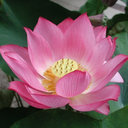Cytotoxicity and modulation of cancer-related signaling by (Z)- and (E)-3,4,3',5'-tetramethoxystilbene isolated from Eugenia rigida.
Klíčová slova
Abstraktní
Bioassay-guided fractionation of the leaves of Eugenia rigida yielded three stilbenes, (Z)-3,4,3',5'-tetramethoxystilbene (1), (E)-3,4,3',5'-tetramethoxystilbene (2), and (E)-3,5,4'-trimethoxystilbene (3). Their structures were determined using 1D- and 2D-NMR spectroscopy and HRESIMS. The sterically hindered Z-stereoisomer 1, a new natural product, was prepared by time-dependent photoisomerization of the E-isomer (2) under UV irradiation at λ254 nm, while 2,3,5,7-tetramethoxyphenanthrene (5) was identified at λ365 nm by UHPLC/APCI-MS and NMR spectroscopy. Compounds 1-3 were tested against a panel of luciferase reporter gene assays that assess the activity of many cancer-related signaling pathways, and the Z-isomer (1) was found to be more potent than the E-isomer (2) in inhibiting the activation of Stat3, Smad3/4, myc, Ets, Notch, and Wnt signaling, with IC50 values between 40 and 80 μM. However, both compounds showed similar inhibition against Ap-1 and NF-κB signaling. In addition, 1 demonstrated cytotoxic activity toward human leukemia cells, solid tumor cells of epidermal, breast, and cervical carcinomas, and skin melanoma, with IC50 values between 3.6 and 4.3 μM, while 2 was weakly active against leukemia, cervical carcinoma, and skin melanoma cells. Interestingly, 2 showed antioxidant activity by inhibition of ROS generation to 50% at 33.3 μM in PMA-induced HL-60 cells, while 1 was inactive at 100 μM (vs Trolox 1.4 μM).




